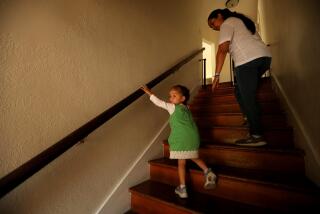Young women are living with Mom and Dad as if it’s 1940

An economist says young women are staying home now because they are half as likely to be married as they were in 1940 and much more likely to be college-educated.
- Share via
Young women are living with their parents or relatives at a rate not seen since 1940 as more millennial women put off marriage, attend college and face high living expenses.
A Pew Research Center analysis of U.S. Census Bureau data found that 36.4% of women age 18 to 34 lived with parents or relatives in 2014, the most since at least 1940, when 36.2% lived with family.
It is a very different world for women now, though, despite the “return to the past, statistically speaking,” says Richard Fry, a senior economist at Pew.
SIGN UP for the free California Inc. business newsletter >>
Fry says young women are staying home now because they are half as likely to be married as they were in 1940 and much more likely to be college-educated. Economic forces such as increasing student debt, higher living costs and economic uncertainty are also playing a role.
Casey Ballard, 29, was living in Portland, Ore., but rent ate up roughly two-thirds of her paycheck and she was ready for a career change. A September move back with family in California allowed her to try out teaching as a substitute, and now she plans to pursue teaching full time.
“There was that element of frustration and feeling like a failure,” she says about returning home. “But then the logical side of me kicked in and said, ‘It’s just fiscally responsible.’”
Young men have historically lived with parents at higher rates than young women, and similar economic and cultural forces are keeping an increasing number of men at home too in recent years. But the rate young men are staying home with their parents and relatives, 42.8%, remains below the 47.5% level for men in 1940.
The percentage of young men and women living with family fell after the 1940s as more women joined the workforce, the overall workforce expanded, and marriage rates increased.
Marriage was once the life event that triggered a move out of the family home, but it is now coming later with each generation, if it comes at all. The median age of marriage for women is now 27, up from 21.5 in 1940. For men, it is 29.3, up from 24.3 in 1940.
Young women and men began staying home or returning there at a more rapid rate after 2000, a trend that sharply increased with the economic uncertainty brought on by the housing collapse and recession in the late 2000s.
Although the retreat home for young adults is also clearly a result of economic pressures, it is not, according to Fry, an employment issue. For example, more young adults are living with their family now than in 2010, even though the job market has improved since then.
“The job market has gotten significantly better” for this group, Fry says. “Unemployment has come down, more have jobs and some are even getting paid a bit more.”
Another factor in the change, Fry says, is increased ethnic diversity across this age demographic, which in turn has introduced cultural traditions of living with parents and relatives longer into life.
“I don’t think it’s as bad as people think it is,” says Stacey Sholes, 26, who moved back into her parents’ house in Fresno eight months ago after leaving college in San Francisco and working in Los Angeles.
Sholes is still a few credits shy of graduating but isn’t sure if she will return because her private school was very expensive and she’s not confident she’ll be able to find a job in the film industry even with a degree.
She is living with her parents while she figures out her next step and has taken a holiday job at the same store she worked when she was 18 to bring in some cash.
There are bumps, like when she fails to tidy up or check in with her parents regularly. But otherwise it’s a comfort to be with her family.
Still, she hopes to find a new place soon with a roommate.
“I have a very loving, supportive family; they don’t give me a hard time about it,” she said. “It’s a good place to crash while I figure my life out.”
ALSO:
Could Iger’s latest move pull Disney back into professional sports?
As bitcoin’s value surges, backers say the currency is headed mainstream
Electric vehicles beat gasoline cars in cradle-to-grave emissions study
More to Read
Inside the business of entertainment
The Wide Shot brings you news, analysis and insights on everything from streaming wars to production — and what it all means for the future.
You may occasionally receive promotional content from the Los Angeles Times.










